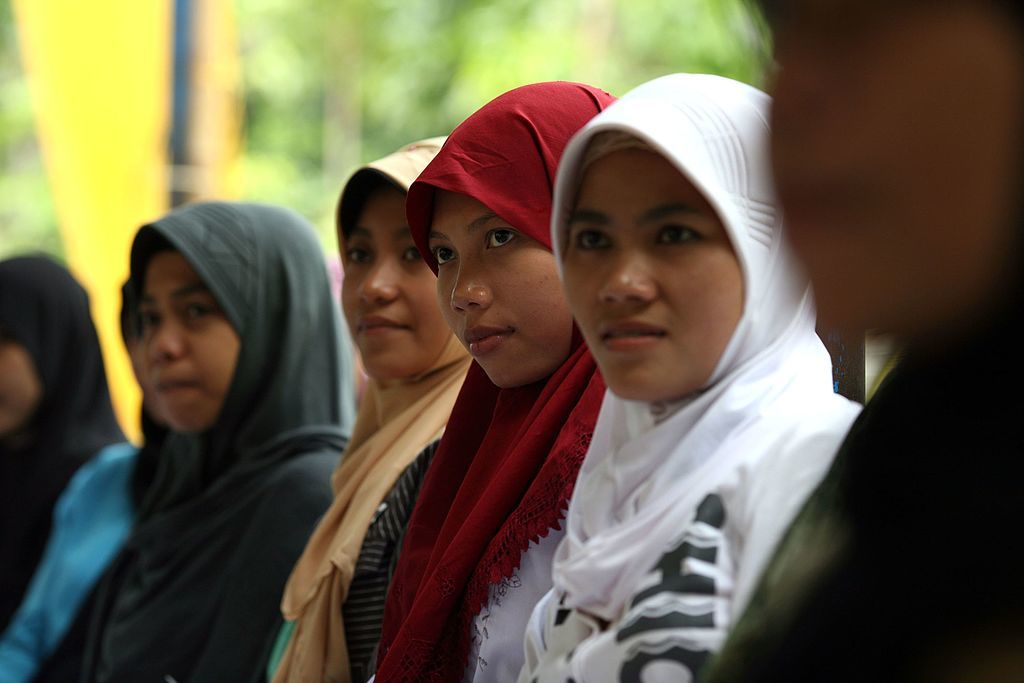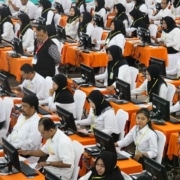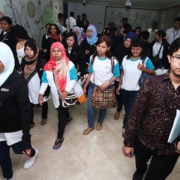
After more than two decades and dramatic economic change, women’s workforce participation in Indonesia remains low. Photo by Josh Estey/Australian Government Department of Foreign Affairs and Trade.
Indonesia has one of the lowest rates of women’s participation in the workforce in the region, and the numbers have remained unchanged for about 20 years.
The absence of women from the workforce not only has implications for women’s empowerment at work and in the home, but also for the nation’s economic development.
At the current rate, Indonesia is unlikely to meet its G20 goal of reducing the gender gap in the workforce by 25 per cent by 2050, signalling a huge loss in productive potential.
So what is keeping women out of the workforce, and why haven’t we seen a change in participation rates in recent decades, even as Indonesia’s economy has undergone massive transformation?
We analysed data from the National Socio-Economic Survey (Susenas), the Village Census (Podes) and the Indonesian Family Life Survey (IFLS) to see if the numbers could tell us more about women’s work patterns throughout their lives, and whether there have been any other changes over time.
Our research shows that although the overall rate of women’s participation in the workforce has remained low, social norms are changing and younger generations of women are more inclined to work, particularly educated young women in urban areas – provided they have the skills and opportunity.
These changes tend to have been offset by changes in industrial structure – such as shrinking opportunities for work in agriculture, a traditionally important sector for women – keeping the overall participation rate low.
A closer look at drivers of participation on both the supply and demand sides indicate the need for policy changes to support women wanting to join or return to the workforce, as well as assisting the government with its goal of increasing women’s participation.
The gender gap
Indonesia has a persistent gender gap in workforce participation between men and women. This is partly explained by cultural norms around gender-based roles and responsibilities in the household, but remains significant even in comparison to culturally similar countries in the region.
Men’s workforce participation is steady at around 80 per cent for most of their working lives, while for women the rate is only 51 per cent, with fluctuations over their lifetime.
Our research finds that marriage, children, level of education, and a changing economic structure appear to be some of the main drivers affecting women’s workforce participation, with differences found over time and in rural and urban areas.
For many women, their working life ends when their family life begins. Today there are around 8.6 million Indonesian women aged 20-44 who left work after getting married and starting a family, and may never return to work, even in the informal sector.
Those least likely to go back to work are women with a moderate level of education, such as senior high school graduates. Those with university degrees tend to go on to use their qualifications after having children, while those with only low levels of education also tend to return to work, possibly because they do not have the option of foregoing an income.
Married women in rural areas are 11 per cent less likely to be working or looking for work than single women, while in urban areas the difference is even greater, at 24 per cent. Considering that 90 per cent of women aged 30-44 are married, this affects a sizeable proportion of Indonesia’s productive age workforce.
For women with children, around 40 per cent are not working one year after having their first child. The presence of a child aged 0-2 in the household reduces a woman’s likelihood of working by about 8 per cent, while for men there is only a small, and positive, difference.
Policy implications
Greater participation by women in the workforce has been shown to have positive effects for women’s empowerment more generally – in political representation, in influencing household decisions for the benefit of women’s and children’s well-being, and in ending situations of domestic violence. It’s also better for the economy.
Indonesia could improve productivity and prosperity by introducing policies that support women’s workforce participation, including through the life changes of marriage and children.
Formal sector employers in particular have the capacity to introduce more accommodating working conditions – such as flexible work hours, compressed work weeks, well-compensated part-time positions, work-based childcare, or the option to work from home – as a way to retain women once they have a family.
For government, supporting higher educational attainment for women could have an impact in reaching goals on closing the gender gap and developing the economy. Higher education and vocational training, particularly for rural women, will open greater access to employment outside of traditional sectors like agriculture, and increase women’s chances of returning to work.
While policy changes at this late stage are unlikely to help the government meet its G20 goal by 2050, the increasing propensity of younger generations of women to work means that with the right support, the numbers can still change for the positive in the long term.









